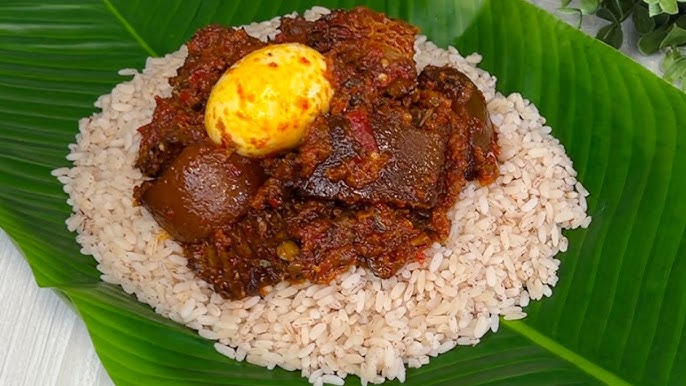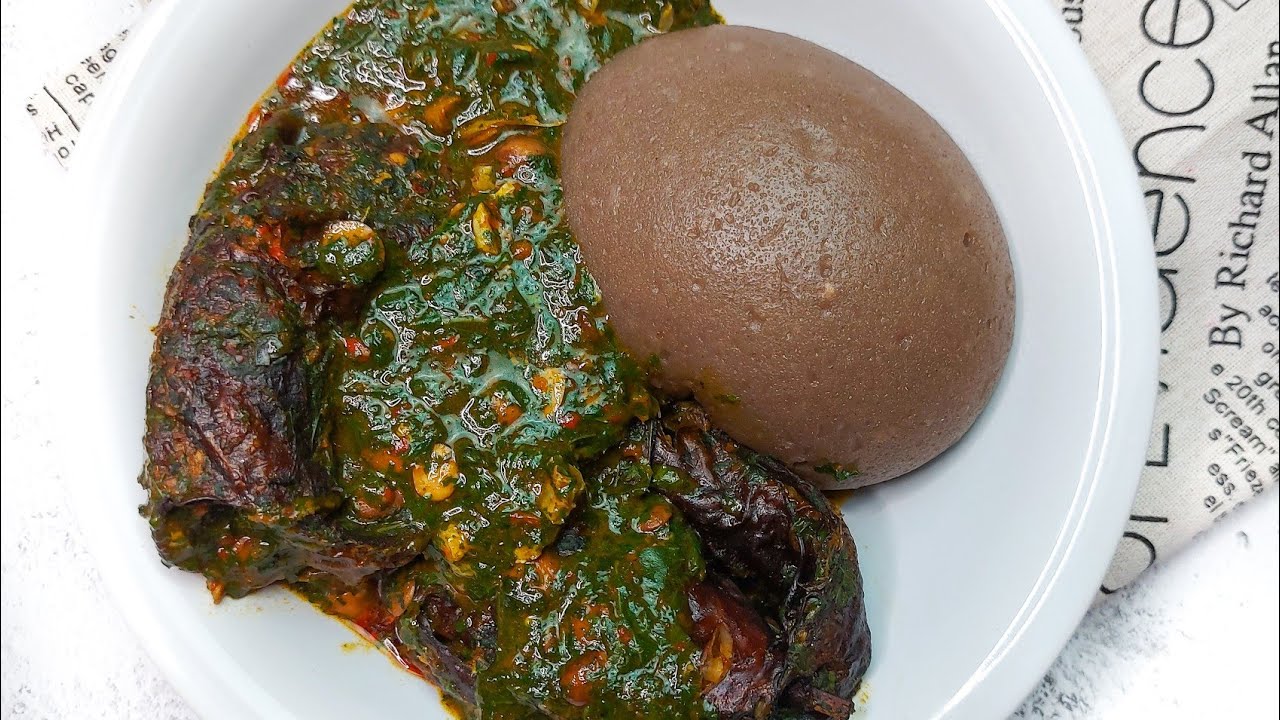
Ofada Rice with Ayamase Sauce: A Perfect Pairing in Nigerian Cuisine

Ofada rice with Ayamase sauce is a classic Nigerian dish that holds a special place in the hearts of many. Known for its unique flavor and aromatic qualities, Ofada rice is an indigenous variety of rice grown in Nigeria, often served with the richly spiced, green-hued Ayamase sauce. This combination is not just a meal but a cultural experience that captures the essence of Nigerian culinary tradition. In this post, we will explore the history, ingredients, preparation, and cultural significance of this beloved dish. The Cultural Significance of Ofada Rice and Ayamase Sauce Ofada rice, named after the town of Ofada in Ogun State, Nigeria, is a short-grain, unpolished rice with a distinctive aroma and nutty flavor. It is often compared to brown rice due to its whole grain nature and slightly chewy texture. Ofada rice is typically served during special occasions, such as weddings, parties, and traditional ceremonies, making it a symbol of celebration and community in Nigerian culture. Ayamase sauce, also known as designer stew or green pepper sauce, originates from the Yoruba people of Nigeria. This sauce is a fiery blend of green bell peppers, Scotch bonnet peppers, and various spices, traditionally cooked in palm oil and combined with assorted meats, offals, and boiled eggs. The sauce is known for its intense flavor and heat, making it the perfect accompaniment to the mild and earthy Ofada rice. Ingredients for Ofada Rice and Ayamase Sauce For the Ofada Rice: Ofada Rice: 2 cups (adjust based on servings) Water: Enough to cook the rice Salt: To taste For the Ayamase Sauce: Green Bell Peppers: 8-10 large ones (seeded and chopped) Scotch Bonnet Peppers (Ata Rodo): 3-5 (adjust based on heat tolerance) Onions: 2 large (one chopped, one blended with peppers) Palm Oil: 1 cup (preferably bleached palm oil) Assorted Meats: A mix of beef, tripe (shaki), and goat meat, pre-boiled Offals: Optional, such as liver or kidney Boiled Eggs: 4-6 eggs, boiled and peeled Crayfish: 2 tablespoons (ground) Locust Beans (Iru): 1 tablespoon Seasoning Cubes: 2 cubes (adjust to taste) Salt: To taste Stock or Water: As needed for the sauce Smoked Fish or Stockfish: Optional, for added flavor Preparation of Ofada Rice Rinse the Rice: Ofada rice is known for its unpolished nature, which means it often contains husk residues. Rinse the rice thoroughly under cold running water to remove any impurities. Soak the rice in water for about 30 minutes to soften it and reduce cooking time. Cook the Rice: In a large pot, bring enough water to a boil. Add the soaked rice and a pinch of salt. Cook the rice uncovered on medium heat for about 20-25 minutes, or until the grains are tender but still slightly chewy. Drain the excess water and set the rice aside. For an authentic touch, you can steam the rice in banana leaves after boiling. Preparation of Ayamase Sauce Blend the Peppers: Combine the green bell peppers, Scotch bonnet peppers, and one onion in a blender. Blend until you achieve a coarse consistency; the mixture should not be too smooth. Set aside. Bleach the Palm Oil: In a large, heavy-bottomed pot, heat the palm oil over medium heat. To achieve the characteristic flavor and color of Ayamase sauce, the palm oil needs to be bleached. This process takes about 10-12 minutes. Heat the oil until it turns from red to a light golden color, but be careful not to burn it. It’s crucial to keep the kitchen well-ventilated during this step, as bleaching palm oil can produce strong fumes. Once bleached, allow the oil to cool slightly. Fry the Onions and Locust Beans: Once the palm oil has cooled slightly, add the chopped onions and locust beans (iru) to the oil. Fry until the onions become soft and translucent, releasing their aroma. Add the Blended Pepper Mix: Pour the blended pepper mixture into the pot. Stir well and cook over medium heat, allowing the mixture to reduce. This process can take 15-20 minutes, during which the oil will begin to separate from the pepper mix, indicating that it is well-fried. Add Assorted Meats and Offals: Once the pepper mixture is well-cooked, add the pre-boiled assorted meats, offals, and smoked fish if using. Stir to coat the meats in the sauce. Allow everything to simmer together for about 10 minutes, so the meats can absorb the flavors of the sauce. Incorporate Ground Crayfish and Seasoning: Add the ground crayfish, seasoning cubes, and salt to taste. Stir well to combine. If the sauce is too thick, add a bit of stock or water to achieve your desired consistency. Add Boiled Eggs: Carefully add the boiled eggs to the sauce, ensuring they are well-coated with the rich, spicy sauce. Allow the eggs to simmer in the sauce for an additional 5 minutes. Simmer and Finish: Lower the heat and let the Ayamase sauce simmer for another 5-10 minutes, stirring occasionally. This final simmering allows all the flavors to meld together beautifully. Serving Ofada Rice with Ayamase Sauce Ofada rice is typically served in a traditional fashion, either on a plate or wrapped in banana leaves to enhance its aroma and presentation. Scoop a generous portion of the cooked Ofada rice onto your serving plate. Ladle the rich Ayamase sauce over the rice, ensuring each serving includes some of the assorted meats and a boiled egg. The combination of the mildly flavored rice and the spicy, flavorful sauce creates a perfect balance that’s both satisfying and delicious. Tips for the Perfect Ofada Rice and Ayamase Sauce Adjust the Heat: The spice level in Ayamase sauce can be intense, especially with Scotch bonnet peppers. Feel free to adjust the number of peppers based on your heat tolerance. Removing the seeds from the Scotch bonnet peppers can also help reduce the spiciness. Bleach the Palm Oil Carefully: Bleaching palm oil is a delicate process that requires patience and caution. It’s best to keep the kitchen well-ventilated to avoid inhaling the fumes. Also, ensure that the oil doesn’t overheat or burn. Use Quality Meats: The flavor of Ayamase sauce is significantly enhanced by the quality and variety of meats used. Opt for fresh, well-cleaned assorted meats, and consider adding smoked fish or stockfish for an extra layer of flavor. Balance the Flavors: Ayamase sauce is known for its bold flavors, so it’s important to taste as you cook. Adjust the seasoning, salt, and crayfish to ensure a well-balanced sauce. Keep it Traditional: While modern variations of Ayamase sauce exist, sticking to traditional ingredients like locust beans (iru) and bleached palm oil will give you the authentic taste that makes this dish so special. Nutritional Benefits of Ofada Rice with Ayamase Sauce Ofada rice is a whole grain, making it a healthier option compared to polished white rice. It is rich in dietary fiber, vitamins, and minerals, which are beneficial for digestion and overall health. The assorted meats in Ayamase sauce provide protein and essential amino acids, while the peppers and onions offer vitamins A and C, promoting good vision and immune health. The palm oil, despite being high in calories, is a good source of vitamin E and antioxidants. Conclusion Ofada rice with Ayamase sauce is more than just a meal; it's a celebration of Nigerian culture and culinary excellence. The combination of the earthy, aromatic Ofada rice with the richly spiced Ayamase sauce creates a dish that’s both comforting and deeply flavorful. Whether you're preparing this dish for a special occasion or simply to enjoy a taste of Nigerian heritage, Ofada rice with Ayamase sauce is sure to impress. So, gather your ingredients, follow these steps, and treat yourself and your loved ones to this iconic Nigerian dish. The vibrant flavors, hearty textures, and cultural significance of Ofada rice with Ayamase sauce make it a true delight that you’ll want to savor again and again.
